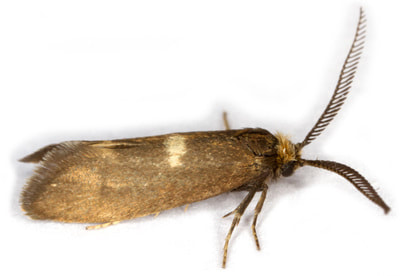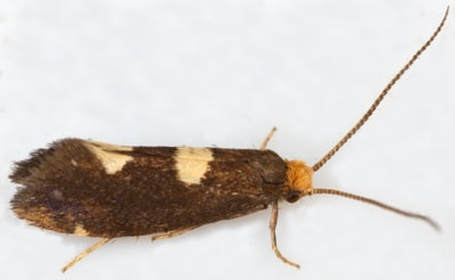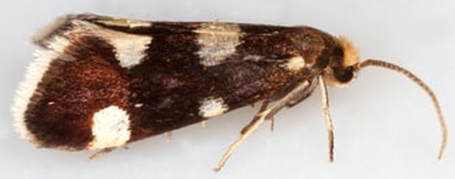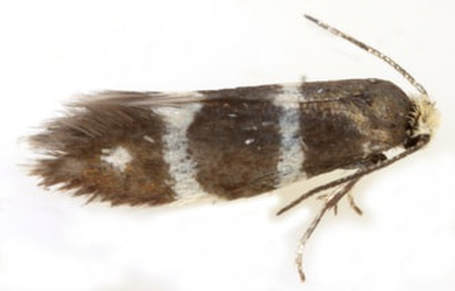Head rough-haired. Antenna shorter than forewing. Proboscis short or rudimentary. Maxillary palps 5-segmented, folded
Single female genital opening
Diurnal, flying in sunshine.
Phylloporia is small (ws 7-9mm), proboscis rudimentary, reduced fw venation (veins 5 and 9 missing). Antenna half length of fw, shortly ciliate in male
Incurvaria is larger (ws 11-16mm), proboscis small. Beyond that difficult to establish what characterises the genus as two of its species were considered to be in genus Lampronia (Family Prodoxidae) in MBGBI1.
Single female genital opening
Diurnal, flying in sunshine.
Phylloporia is small (ws 7-9mm), proboscis rudimentary, reduced fw venation (veins 5 and 9 missing). Antenna half length of fw, shortly ciliate in male
Incurvaria is larger (ws 11-16mm), proboscis small. Beyond that difficult to establish what characterises the genus as two of its species were considered to be in genus Lampronia (Family Prodoxidae) in MBGBI1.
Incurvaria (4S)
|
001 Incurvaria pectinea
(Pale Feathered Cutter) |
002 Incurvaria masculella
(Feathered Cutter) |
|
Phylloporia
|
Symacauda
|
|
005 Phylloporia bistrigella
(Striped Cutter) |
006 Symacuda dicommatias
A South American species discovered at Trengwainton Garden, Cornwall in 2020. lfp Chilean Myrtle (Luma apiculata) Added to the main list in the 7th update (Jan 2024) Seems likely that this is an adventive species. I am unaware of the justification for placing it on the main list. |
Key to species
All species have a pale (white) dorsal spot in basal half of fw and a pale tornal spot.
Phylloporia bistrigella can be distinguished by small size (ws 7-9mm) (fw with 2 white fasciae, the distal of which may not be complete). Incurvaria spp have ws 11-16mm.
I.pectinea has the dorsal and tornal spots obscure and no costal spots.
I.masculella has the white dorsal and tornal spots distinct and usually no costal spots.
The males of both I.pectinea and I.masculella have pectinate antennae (a feature not shared by the other species).
I.oehlmanniella has a small costal spot opposite or distal to the tornal spot. (when I.masculella has a costal spot it is proximal to the tornal spot).
I praelatella usually has the dorsal spot extended into a complete basal fascia, a small spot at base of fold and a distinct costal spot opposite the tornal spot.
All species have a pale (white) dorsal spot in basal half of fw and a pale tornal spot.
Phylloporia bistrigella can be distinguished by small size (ws 7-9mm) (fw with 2 white fasciae, the distal of which may not be complete). Incurvaria spp have ws 11-16mm.
I.pectinea has the dorsal and tornal spots obscure and no costal spots.
I.masculella has the white dorsal and tornal spots distinct and usually no costal spots.
The males of both I.pectinea and I.masculella have pectinate antennae (a feature not shared by the other species).
I.oehlmanniella has a small costal spot opposite or distal to the tornal spot. (when I.masculella has a costal spot it is proximal to the tornal spot).
I praelatella usually has the dorsal spot extended into a complete basal fascia, a small spot at base of fold and a distinct costal spot opposite the tornal spot.
All images © Chris Lewis





